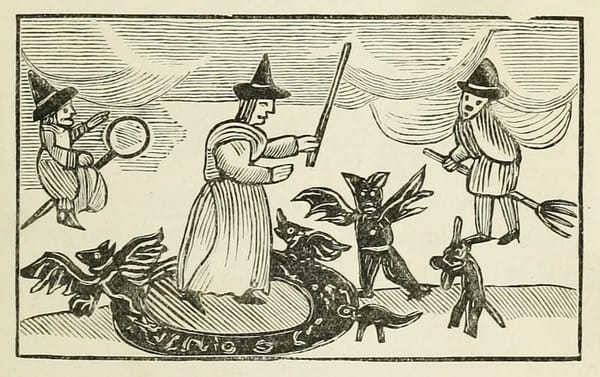Note 7: Liminal horror
On the creepy-crawlies that live in the space right before you succumb to the void of slumber.
It’s been a very busy week in the office. I’ve been leaving early and getting home late. Some days, I don’t see the sun, and while fetching lunch yesterday, a woman asked me how to get outside and I had to think harder than I should have when coming up with directions to escape Chicago’s Merchandise Mart.
We’ve got lots to cover today, so let’s get into it.
Terror as you drift away
In light slumber he descended the seventy steps to the cavern of flame and talked of this design to the bearded priests Nasht and Kaman-Thah. And the priests shook their pshent-bearing heads and vowed it would be the death of his soul. They pointed out that the Great Ones had shewn already their wish, and that it is not agreeable to them to be harassed by insistent pleas. They reminded him, too, that not only had no man ever been to unknown Kadath, but no man had ever suspected in what part of space it may lie; whether it be in the dreamlands around our world, or in those surrounding some unguessed companion of Fomalhaut or Aldebaran.
H.P. Lovecraft, The Dream Quest of Unknown Kadath
Last week’s note discussed Lovecraft’s role in introducing the cosmic horror subgenre to audiences in the early twentieth century. This week, I’ll use some of his works as a departure point to discuss another of my favorite horror subgenres: liminal horror.
Where cosmic horror highlights terrors found in distant places and times, liminal horror is much more personal: it’s the horror that you experience at the boundary between the waking world and the sleeping world. If you’ve ever been awake in the middle of the night, and your mind won’t let go of the the ruminations of your own mortality, you’ve experienced liminal horror.
In his own works, Lovecraft wrote explicitly liminal horror, most notably his sequence of Randolph Carter stories, where young Carter seeks to rediscover the golden city of his dreams and ventures to the center of creation to find it. One of my favorite adaptations of all time is the feature-length animated adaptation of The Dream Quest of Unknown Kadath:
While Lovecraft revisited this theme frequently - see also The White Ship (1919), Beyond the Wall of Sleep (1919), Polaris (1920), and The Strange High House in the Mist (1931) - he was hardly the originator of this style of storytelling and was building on the tradition established by earlier authors such as Robert W. Chambers and Algernon Blackwood.
Blackwood is best known for his dreamlike story The Willows (1907), where a duo canoeing on the Danube find their minds being manipulated by the local environment:
Sleepy at first, but later developing violent desires as it became conscious of its deep soul, it rolled, like some huge fluid being, through all the countries we had passed, holding our little craft on its mighty shoulders, playing roughly with us sometimes, yet always friendly and well-meaning, till at length we had come inevitably to regard it as a Great Personage.
Chambers - primarily a historical fiction author - penned the keystone of the liminal horror subgenre in his alternate future, The King in Yellow (1895). If you haven’t yet seen the Yellow Sign, Chambers wrote a collection of short stories revolving around The King in Yellow, an underground and suppressed work of theatre, where those who witness it go mad or meet worse fates.
Camilla: You, sir, should unmask.
Stranger: Indeed?
Cassilda: Indeed it's time. We have all laid aside disguise but you.
Stranger: I wear no mask.
Camilla: (Terrified, aside to Cassilda.) No mask? No mask!
Act I, Scene 2D, The King in Yellow
If this sounds familiar, you likely encountered the Yellow King and his trappings in the first season of True Detective (2014):
Chambers’ collection of short stories are told in a very liminal style, and by virtue of being a story of the future as told in 1895, the tales are set in the United States in the 1920s in a timeline that is wholly alien, yet entirely recognizable:
In the city of New York the summer of 1899 was signalized by the dismantling of the Elevated Railroads. The summer of 1900 will live in the memories of New York people for many a cycle; the Dodge Statue was removed in that year. In the following winter began that agitation for the repeal of the laws prohibiting suicide which bore its final fruit in the month of April, 1920, when the first Government Lethal Chamber was opened on Washington Square.
It’s in this strange distant offshoot of our own timeline where Chambers’ characters orbit the Yellow King.
In addition to invoking Chambers’ regal being, the 2014 HBO series also links us to the modern master of liminal horror, Thomas Ligotti. A thoroughly pessimistic thinker, Ligotti penned The Conspiracy Against the Human Race (2010), where he argues against the upsides of self-awareness:
For the rest of the earth’s organisms, existence is relatively uncomplicated. Their lives are about three things: survival, reproduction, death—and nothing else. But we know too much to content ourselves with surviving, reproducing, dying—and nothing else. We know we are alive and know we will die. We also know we will suffer during our lives before suffering—slowly or quickly—as we draw near to death. This is the knowledge we “enjoy” as the most intelligent organisms to gush from the womb of nature. And being so, we feel shortchanged if there is nothing else for us than to survive, reproduce, and die. We want there to be more to it than that, or to think there is. This is the tragedy: Consciousness has forced us into the paradoxical position of striving to be unself-conscious of what we are—hunks of spoiling flesh on disintegrating bones.
Rust Cohle in True Detective:
It’s from this dark corner where Ligotti produces his best fiction. Some of it is explicitly liminal (Songs of a Dead Dreamer, 1985), but the disorientation you feel when you fall deeply into a Ligotti tale is more an element of his writing style than any setting or plot. Ligotti provides just enough detail to hook your imagination, while leaving out the rest that you must mentally fill in yourself. Ligotti grounds his stories in the everyday world, and the horror emerges as his prose takes you just enough beneath the surface to experience the horror of reality that lies beneath all of us. A fall festival in an American farm town provides cover for a much older and inhuman ritual. Continuous education leads to a dark enlightenment. Puppets.
When I’m deep into Ligotti’s prose, I end up in an mental state not like right before falling asleep. It takes some time to recover from the fugue, not unlike waking up after a deep afternoon nap. The only other author that has had that effect on me is Jeff VanderMeer in his Southern Reach Trilogy (2014). I mentioned this work last week in the cosmic horror context, but another facet of VanderMeer’s writing is how well he captures the sleepy numbness of being trapped in a Kafkaesque bureaucracy. Where the first volume, Annihilation, is solid cosmic horror, the subsequent volumes (Authority and Acceptance) explore what happens when an alien presence arrives on Earth to stay, humans never get any closer to understanding it, and then move on after a couple of decades of unsuccessful attempts at solving the enigma, leaving behind a cadre of scientists and administrators to keep an eye on it, just in case something should happen.
While not as strong as Ligotti and VanderMeer in the liminal horror tradition, Tim Powers is a modern author worth mentioning in this context. Powers has a simple, but devastatingly-effective formula for his stories: take a historical event and fill in the gaps in the history with supernatural putty. Last Call (1992) uses the Fisher King legend to tell the whole story of the gangster Bugsy Siegel and the founding of Las Vegas. Declare (2000) explores the events around the Kim Philby and his betrayal of the British secret services as Cold War powers race to ally themselves with supernatural beings in the mountains of Turkey.
These are all great works, but Powers’ most liminal tale is contained within The Stress of Her Regard (1989) and Hide Me Among the Graves (2012). These two volumes explore the lives of the Romantic poets and writers surrounding Percy Shelley and Lord Byron in world where a vampires and other supernatural beings stay just beyond the edges of our perception. John Polidori, the original creator of the vampire story, is a key figure, as well as Mary Shelly, author of Frankenstein and inventor of the science fiction genre. What makes this story a liminal tale isn’t its secret history (a few centuries ago is hardly deep time), but how it reveals the hidden foundation on which so much of our modern Western literary tradition rests and your own waking eyes would have trouble recognizing.
If liminal horror sounds like something worth exploring, rather than jump into Chambers, VanderMeer, or Ligotti(!) head-first, a great place to start is the 2015 female-authored collection Cassilda's Song: Tales Inspired by Robert W. Chambers King in Yellow Mythos. There are some great tales within that will readily reveal if liminal horror is for you.
On that note, I’ll close with another GUNSHIP track, this one being the best musical encapsulation of liminality (lyrics) that I’ve encountered (and one of my top-5 favorite songs):
Other October 2020 Notes on Horror: Cosmic Horror, Folk Horror.
Local updates
One of my major tasks for this week was getting our tax situation for 2019 wrapped up. COVID threw everyone off schedule and my bookkeeper was AWOL with some form of sickness for weeks, which threw things off even more. One of the decisions I have to make each year is how much I want to decrease our taxable income by contributing some amount to my self-employment retirement plan. It usually involves moving an uncomfortable amount of money to my brokerage (it’s only uncomfortable because I haven’t been contributing all year like I should), and then deciding how to invest those funds so I don’t end up on the breadline when I’m too old to work.
I’m usually fairly conservative in those investments (for my age), typically splitting the funds between low-load index funds, such as the Vanguard S&P 500 ETF or a related growth or value fund. This week, I was dealing with the question of whether to hold off on purchasing a fund until the market went down (I decided against trying to time the market) and whether I wanted to place any bets that are more ambitious than “the market (or a subset) will rise”. I ended up placing two bets on the side of my larger annual index fund purchases.
The first bet I made was that the commercial space sector would grow in economic importance before I retired. I’d already gotten my toes wet with some shares of Virgin Galactic, and I wanted to see what my options were. (Left to my own devices, I’d throw all my cash into SpaceX, but they are not publicly traded. Alas.) I ended up investing in an ETF focused on the space sector: the Procure Space ETF (ticker: UFO).
The second bet that I made was that post-COVID, there will still be a theatrical cinema industry, and I purchased shares of AMC Entertainment Holdings, the parent company of AMC Theaters, after news broke the company is facing a major cash crunch before/in early 2021. Since I like to have a “story” about how this investment works out, I came up with two for this purchase:
The first AMC “story” is that we beat COVID and pent-up demand for external entertainment brings the cinema business back to life. Given that AMC is a larger player in this market, it will be in a decent position to absorb any competitors more severely impacted by COVID and will enjoy a dominant market position moving forward.
The second AMC “story” is that the traditional cinema business does not come back, but large entertainment conglomerates are not prepared to abandon the Billion Dollar Summer Movie quite yet. A company like Disney or Amazon purchases AMC for the venues for their own studios’ work (this is now becoming legal after the better part of a century) and the purchase price will exceed that of AMC’s depressed market cap after this morning’s news.
I made some similar bets back around 2010 that paid out quite handsomely (Ford, Apple, and Microsoft), so we’ll see how I end up doing in this go-around.
Interesting links
Outnumbered in Eve Online: surviving the biggest battle in MMO history (Polygon)
Death by black hole: Astronomers spot flare from “spaghettification” of star (Ars Technica)
With Polling Sites Lacking Workers, a New Generation Steps Up (New York Times)
Have a great week!



